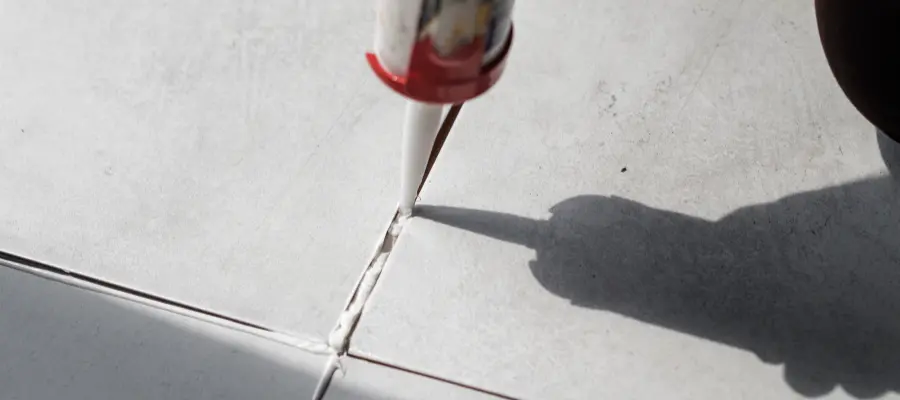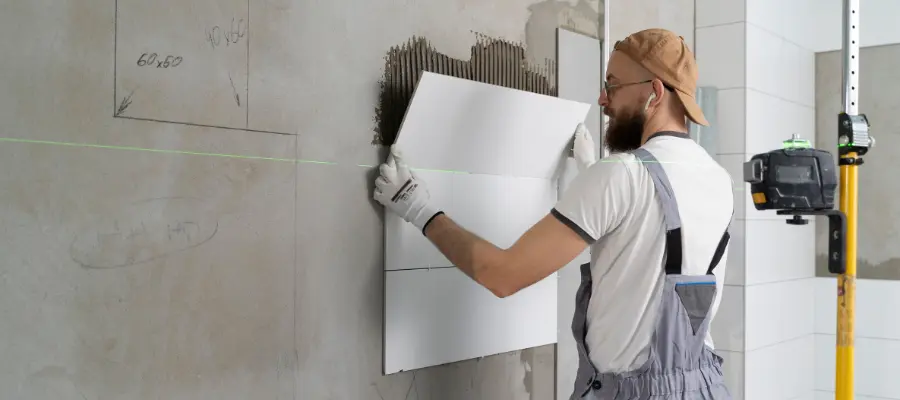Grouting is one of the major processes used in construction. It improves the overall strength and performance of the house structure. It reduces the pain points, which weaken the structure.
In today’s blog from Brick & Bolt will provide a detailed guide on grouting in construction, its types, different applications, advantages, grout repair and sealing processes.
What is Grouting in Construction?
Grouting in construction can be explained as applying a dense fluid called grout to fill gaps, voids, or spaces within structures. Grout is a fluid mixture typically made from sand, cement, water, or a liquid prepared from a combination of chemical substances. In particular applications, gravel can also be added to the mix of sand, cement, and water to strengthen large areas like the core of concrete blocks.
The main goal of grouting in construction is to enhance structural integrity and load-bearing capacity and provide stability to various elements of a construction project. Grouting resists the accumulation of water, air, or debris, which are reasons for weakening the structure over time.
Types of Grouting in Construction

Based on the type of construction and its requirements, grouting materials are prepared. The following are the different types of grouting.
- Cementitious Grouting
- Chemical Grouting
- Resin Grouting
- Bentonite Grouting
- Bituminous Grouting
- Compaction grouting
- Structural grouting
- Epoxy Grout
- Polyurethane grout
- Acrylic Grout
1. Cementitious Grouting
Cementitious grouting is the standard type of grouting. This type of grout is formulated from cement, water, and sometimes sand. This type of grout is best for concrete grouting (sealing voids in concrete structures), repairing cracks, and enhancing the load-bearing capacity of home foundations. The grout material is infused with great pressure to fill the hole in a specified radius around the area. It is normally used to seal wide cracks in gravity dams, canal linings, foundations, and thick concrete walls.
2. Chemical Grouting
The chemical grouting process includes using grout made of acrylamides, polyurethanes, acrylates, epoxy, and sodium silicates. You can use this type of grout as a waterproofing option, a soil stabilisation agent, and for repairing underground structures. The grouting is performed through two processes, i.e., the Two-shot and One-shot processes.
Two-Shot Process
The pipe is inserted into the ground through a drill during this process. After this, the chemical material is pumped through the pipe in such a way that another follows into the soil. So that the soil can solidify rapidly during the chemical reaction process.
One-Shot process
In this method, a chemical mixture of grouting material is prepared in advance and then poured underground. This efficient process takes time for the structure to harden. This one-shot process is generally used for boreholes.
3. Resin Grouting
Resin grouting in construction involves the use of epoxy grouts or reactive resin grouts. It is also called as bathroom grout. This grout is made up of epoxy, polyurethane, or other liquid resins that solidify to form a strong bond when cured. It is not waterproof, but it can absorb water when it gets wet. These resins give high tensile and compressive strengths. It is usually used to repair concrete cracks because of its outstanding adhesive bonding and strength.
4. Bentonite Grouting
Bentonite grout is a gel-like solution created by mixing bentonite clay and water. It expands when it comes into contact with water. Because of its specialised nature, this grout is ideal for filling cavities in wells and boreholes. Additionally, it acts as a waterproof grout.
5. Bituminous Grouting
Bituminous grouting is the process of sealing and waterproofing roofs, foundations, and basement structures, resulting in high water resistance.
It is highly durable and immune to UV radiation and extreme weather conditions. This form of grout is utilised when water penetration must be confined, such as tunnels and underground constructions.
6. Compaction grouting
Compacting grouting is used to improve the density of soil, so it is also known as the ground improvement technique. The main components are sandy materials including fines like cement, fillers etc.
7. Structural grouting
This grouting is different from others as it includes critical infrastructure projects. The selection of the grouting always aligns with engineering specifications and intended purpose. Either epoxy grouting or polyurethane grouting is used according to the structural needs.
8. Epoxy Grout:
Epoxy grout is a mixture combined with epoxy resin and filled powders. It is a high-performance resin used in residential buildings and commercial buildings. It is used as they have low water absorption and high compressive strength.
9. Polyurethane grout:
It is a modern technique used to prevent water leakage. Compared to other grout, polyurethane will be more elastic. After applying this grout, the result will be quick and stops the flow of water.
10. Acrylic Grout:
This grout is made of acrylic polymers. In this, water-based material is very flexible for grouting. By using this grouting, the result will be fast cure. It is used for crack sealing, joint filling and shadow void filling.
Procedures Involved in Grouting
Preparation of Grout Materials
Prepare the required grouting material with the needed materials and mix it thoroughly. You can mix mechanically or with an electric drill at minimum speed.
Surface Preparation
Prepare the surface for grouting by thoroughly cleaning it with a high-pressure jet or blast cleaner. The concrete surface must be pre-soaked with water to guarantee that it remains saturated during the operation.
Grouting in Construction
- Pour the grout mixture on the prepared surface. Take care to move out air easily. If air bubbles are trapped in the grout, it will hinder a firm grip on the grouting surface.
- While grouting wet, porous surfaces in dry conditions, maintain constant and sufficient pressure to keep the grout flowing at all times.
- To apply the grout uniformly, use a grout mixture to pour the grout as fast as possible, preferably within a maximum of 15 minutes.
Applications of Grouting in Construction
The following are the applications of grouting in construction:
- To Improve Foundation Stability: Grouting is a technique used to stabilise and strengthen the foundation of constructions. It can fill cavities and increase the soil’s load-bearing capacity beneath foundations, thus avoiding settlement and enhancing overall stability.
- Improving Soil: Grouting can help enhance the properties of weak or loose soils. It contributes to soil strength, reduces permeability, and improves overall stability, allowing structures to be built in otherwise difficult terrain.
- Underground Structures: Grouting is required for tunnelling projects to control water infiltration and stabilise the surrounding soils or rocks. It can seal water leaks, reduce soil movement, and provide a stable environment for tunnel excavation and construction.
- Sealing Dam and Embankment: Grouting is used in dam and embankment construction to reduce water seepage and increase structural stability. Grout is injected into potential water channels to minimise permeability and form an impenetrable barrier.
- Fixing Concrete Cracks: Cracks in concrete structures can be repaired by applying grout directly into them. This technique seals them, restores structural integrity, and prevents future degeneration. Hence, it is used in house buildings, bridges, and dams.
- Joint and Void Filling: Grouting is used to fill voids, joints, and gaps in concrete structures. It increases structural integrity, durability, and resistance to water penetration. It’s widely used in precast concrete buildings and infrastructure restoration.
- Groundwater Control: Grouting confines groundwater flow in construction projects, including underground excavations and foundations in water-bearing soils. It entails injecting grout into the earth to form a barrier that prevents water infiltration and stabilises the excavation.
- Tile Installation:During the tile installation period, grouting is necessary to keep the surface moisture and fill the gaps between tiles or stones. Especially, the grouting paste is used in wet areas like bathrooms and kitchens.
- Bridge repair:Using a grout mixture helps to fill voids and secure anchorages. Epoxy grout is used for bridge repair which is impermeable in water.
- Concrete Repair:The grouting mixture is used in the concrete to repair the crack in the wall and fill the gap.
- Foundation Stability:Applying grouting helps to keep the foundation to be more stable. By injecting this grouting mixture, bear the heavy load. So there will be proper soil stabilization and it acts as waterproofing.
- Groundwater control:Here grouting is applied to control the groundwater as it helps to maintain soil stability and strength. It is controlled because of the injection which contains a mixture of cement, water and chemicals.
Advantages of Grouting
- It is beneficial for slab jacking, such as levelling or lifting deformed structures.
- Grouting techniques help fill the cracks in the walls and pillars.
- Waterproof grouts are used to control water leakage in mines, tunnels, dams, and underground structures.
- Grouting can be done on any soil/land condition.
- Grouting in building structures does not cause vibrations and may be managed to prevent distortion.
- Grouting the foundation can enhance site stability.
- Tile grout is, of course, the major application for attaching tiles to walls.
Grout Repair and Sealing

Poor mixing or application techniques will cause the grout to crumble. To fix it with Grout repair and sealing, follow these steps:
- First, get an available removal tool and remove the crumbling grout. You can use bleach to clean the scraped areas.
- Take some time and pick the right type of grout, as per your needs.
- Use a rubber grout float or even your gloved finger to fill the grout well into the gaps correctly.
- You can clean with a damp sponge to remove any excess grout from the different types of tile surfaces. Wait about 15 minutes to set the grouting, and then you can wipe away any remaining residue.
- After you’ve properly applied your grout, seal it to help ensure its lifespan. Wait about a week for the grout to completely cure before applying colourant or sealing it.
Conclusion
Grouting is an important process in both the construction and renovation of home building. It helps to enhance structural integrity, strengthen foundations, seal cracks and joints, and waterproof structures. Contractors can choose the most suitable grout from different grouting types as per the project’s specific requirements. As the construction industry continues to evolve, grouting techniques and materials will also advance further, presenting even more efficient and effective solutions for different construction challenges.
If you are planning to construct your home, which will likely involve tiling work requiring grouting, then don’t worry, Brick & Bolt is here to help you. You can construct your dream home with our trusted construction company in Ghaziabad, calculate your house construction cost with our cost estimator, and experience hassle-free construction with our experts.
FAQs
No, because it depends on the quality of grouting you apply and the maintenance of your construction. So if you use branded grouting with the correct ratio, it expands for many years but does not last forever.
It depends upon the damaged area. It may vary from one another. So if you have any doubts, you may with the manufacturer’s recommendation.
No, you cannot use it without proper safety equipment. Because some minute particles present in the components may affect your health and you will face the risks in future. Use proper equipment before grouting.

